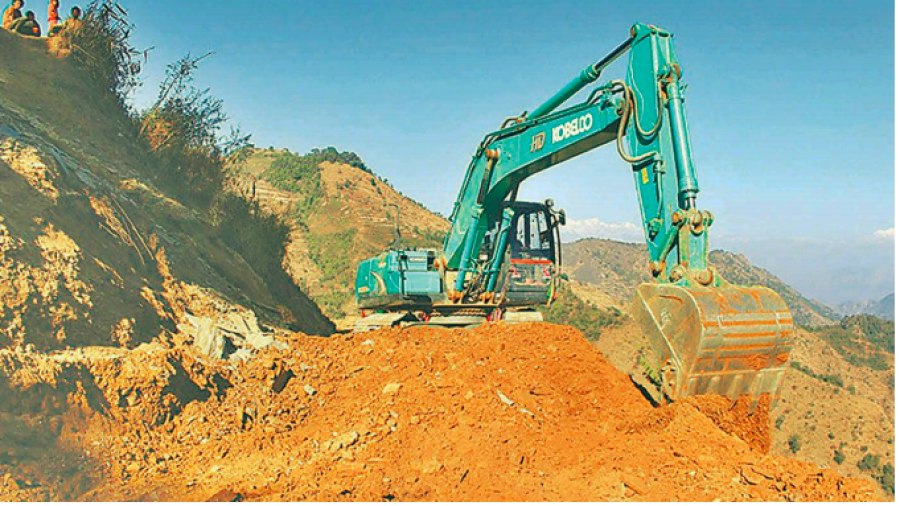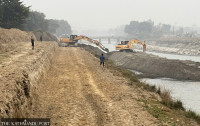National
Federal government keeps small road and bridge projects to itself defying spirit of federalism
Despite projects launched being incomplete, new bridge and road projects are added to government programmes due largely to pressure from politicians, officials say.
Prithvi Man Shrestha
The road to federalism seems a bridge too far even almost five years after the constitution promulgation and three years after the elections that installed three tiers of government.
While provincial and local governments complain about the federal government’s reluctance to devolve powers, politically, the centralised mindset seems to continue when it comes to infrastructure projects like roads and bridges.
A case in point is the functioning of the Department of Roads.
The federal government’s failure to allow provincial governments to execute projects has meant the road department is overwhelmed with 1,101 bridges and 492 road projects this fiscal year.
Appendix 5 of the Constitution of Nepal says the only national highways come under the purview of the federal government. This means other smaller highways and roads and bridges are the responsibility of provincial or local governments.
There are around 80 national highways like the Prithvi Highway, East West Highway, North South Corridors and Mid-Hill Highway.
“But with these small bridges and roads under the department we have no option but to spend a lot of time on them instead of focussing on large national highways, flyovers and tunnels,” said Arjun Suwal, an information officer at the Department of Roads. “The procurement process in smaller projects also takes almost as much time as for large projects.”
Provincial governments do not have the requisite manpower because they have not been able to recruit staff due to the lack of relevant laws and those at the centre do not want to be deputised under the provincial governments.
“The federal government officially handed over the division road offices in Lahan and Chandranigahapur to Province 2 but the staff there did not come under our jurisdiction,” said Jitendra Sonal, physical infrastructure minister of Province 2.
The Department of Roads itself, with some 2,000 employees, is short-staffed even to look after the national highways, according to Dipak Bhattarai, chief of bridge division at the department.
“Hardly anyone from the road department went to work under the provincial government,” said Bhattarai.
Other than the manpower, there is also the issue of insufficient funds.
“The federal government awards a contract of, say, Rs120 million for a bridge but allocates a budget of Rs840,000, and then wants to hand over the project to the province with a limited budget,” Sonal told the Post.
The bridge projects at Rakaiwar in Kailali and Jhalari Papalati Municipality in Kanchanpur are among over 100 local bridge projects in which the federal government has allocated Rs 700,000 each in the current fiscal year.
“Smaller projects being implemented by the federal government have not come under the provincial government because the federal government is not willing to hand them over to the provinces,” said Jhapat Bohara, economic affairs minister of Sudurpaschim Province. “Most of the smaller projects being implemented by the federal government have remained incomplete for several years.”
In the case of these two particular bridges, the department, however, has a different view.
“These bridges are on the verge of completion. Therefore a limited budget was allocated to finalise them,” said Bhattarai. “But even for projects which have just started, the resource allocated is very limited.”
It is unlikely that all these 1,101 bridges and 492 roads will be completed by the end of this fiscal year.
The number of projects continues to increase every year without older ones being completed, and this has been the trend in the country over the years, say officials.
“Small projects to be implemented have increased over time because politicians make promises to build certain projects in their electoral constituencies and the government includes in its annual plan,” said Bhattarai . “Therefore the projects pile up without a single project receiving a sufficient budget.”
While it is normal for a bridge to cost over Rs60 million, an average of Rs6 million has been allocated for each bridge with a total budget of Rs6.85 billion for 1,101 bridge projects in the current fiscal year.
This number of bridges on smaller highways and roads for the current fiscal year 2020-21 is down from 1,137 in the previous fiscal year. But the budget has actually gone up from Rs4.57 billion in the previous fiscal.
Instead of allowing the provincial governments to implement the local bridge projects, the federal government has added nearly 200 new bridge projects under its jurisdictions in the current fiscal year, according to Bhattarai.
The number of local road projects to be implemented by the road department has been increased to 492 in the current fiscal from 442 in the last fiscal year. But, the total budget for them has been brought down to Rs1.96 billion from last year’s Rs4.45 billion.
This discrepancy is there because every year the government only works on a certain portion of the roads depending on the availability of the funds.
Officials at the federal government have also been arguing that the provincial governments didn’t want to take over these projects despite their repeated efforts.
But the provincial governments are of the view that the federal government just wants to dump these projects to the provincial governments without necessary financial and human resources.
“The central government does not have a clear idea about how to hand over the projects to the provinces even though it has been three years since provincial governments were formed,” said Sonal of Province 2.
Bohara of Sudurpaschim Province has similar charges to make against the federal government even though he belongs to the Nepal Communist Party.
“The federal government should come up with a clear plan for how long it wants to cling on with such a small project,” said Bohara. “If it hands over to us with adequate financial resources, we will be able to complete them in time.”
Not only the roads and bridges, the federal government is implementing several projects related to urban development such as those related to improvement of local level roads, construction of bus parks and construction of local level buildings, but the budget for them is insignificant.
For example, the federal government has allocated just Rs100,000 to construct roads and drainage at Sunwal Municipality in Nawalparasi under the Urban Infrastructure Investment Programme, according to the annual programme of the Ministry of Urban Development and Physical Infrastructure.
Khimlal Devkota, who writes extensively on fiscal federalism, said the federal government has violated the spirit of federalism by keeping the provincial level projects under its jurisdiction.
“When the provincial governments were formed three years ago, it made sense that the federal government implemented the smaller projects too as provincial governments didn’t have the capacity to implement them without financial and human resources as well as experience,” said Devkota, also the former vice-chairperson at the Policy Commission of Bagmati Province. “But the capacity of the provincial governments continued to be constrained since the federal government failed to send its employees to the provinces to work.”
As a result, politicians in Kathmandu have a tendency to keep even the smaller projects, questioning the capacity of the provincial governments, according to him.
Officials at the road department say their hands are tied as they need proper guidelines and political decisions if they were to let the sub-national bodies deal with the projects.
“Without a political decision to completely hand over such roads to the provincial and local governments, we can do nothing,” said Suwal of the Department of Roads.




 12.12°C Kathmandu
12.12°C Kathmandu















